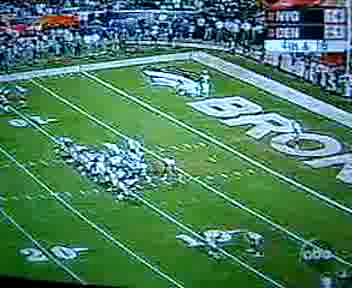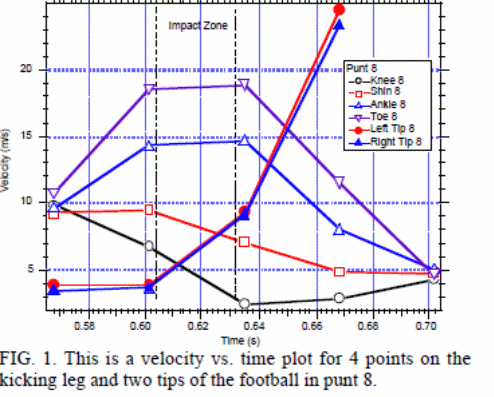Introduction
Football is a sport that has gained popularity in leaps and bounds especially in recent years. Majority of the fans enjoy the sport for the fun of it and the players enjoy it because of variant reasons. However very few people really get to actually appreciate the physics that is incorporated in a football game. Today we are going to help analyse the physics concepts that are involved in a football game. We will demonstrate how physics is used within the game of football, by breaking down the properties of every play scenario. The overall purpose of this presentation is to help all of us gain a better understanding of how a quarterback like Tom Brady can throw a football fifty yards in the air and why a running back like Chris Johnson can run a 4.2s on the forty yard dash.
Punting a football

The punter comes to the field essentially after the offense fails to move the ball ten yards on three plays, and his job is to drop the ball and kick it out of mid-air, aiming to pin the opposing team with the worst possible field position, even using different spins to make the ball bounce a certain direction (Anonymous, “Football physics”).
A good punt can be considered as a kick that goes very high and very far, or it can be considered as a kick that is strategically placed with backspin in order to down the ball close to the opposing teams’ end-zone.
To complete a good punt three properties must be considered at the instant of the kick; velocity, the angle of the kick and the rotation of the ball.
As the kicker drops the ball the speed with which the ball leaves the kicker’s foot is the velocity.
The distance of the punt will be determined by the angle the ball is kicked at, combined with it’s velocity. When a punter wants to have more hang time but have the ball travel a shorter distance, he will kick the ball at a steeper angle with high velocity (Fredeurich, “How The Physics of Football Works”).
A punter will do this to allow his players to reach the punt returner right as the returner catches the ball. If the punter wants to have less hang time but have the ball travel a longer distance, he will kick the ball at a less steep angle with a high velocity.
A punter uses this type of punt when his team has bad field position and he is trying to kick it as far as possible. The last aspect that affects a punt is the rotation that the punter will put on the ball.
The key to having a good punt is for the ball to have less air resistance.
In order for this to happen, the punt must be spiralling through the air which decreases air resistance, as opposed to a punt which is kicked end over end which will result in it having more air resistance, and will not travel even close to as far (Klaud, “Football Field Goal Physics”).

Throwing the football
The physics involved in throwing a football can be compared to that in punting a football. When a football is thrown into the air it takes on a parabolic path, meaning it starts where the quarter back releases the ball, goes up until it hits it’s peak, stops shortly at its peak, and due to gravity it comes down from its peak and accelerates until it hits the ground.
The velocity used by the quarterback, combined with the release point where the quarterback lets go of the ball, will determine how much air time the ball will have (Gay & Belichick 48).
The rotation of the ball determines how accurate the throw will be. Like punting, if the pass is thrown as a spiral it will go farther and more accurate than a throw that comes out of the quarterbacks hand and flutters through the air.
The path of the football that is thrown into the air is called projectile motion.
Runners in the field
Runners in a football field heavily rely on physics when running. Newtonian laws are mostly applied during the running. There are 3 different scenarios which we will discuss; where a player lines up before the play, changing directions during a play, and running in the open field.
When looking at where players line up on the field we have to consider their positions. Typically, defensive and offensive backs line up furthest from the line of scrimmage in order to be able to accelerate from their resting state while reaching a high speed, in order to make a play at their respective positions.
Lets take a look at a player changing directions on the field during a play. This takes place when a quarterback hands the ball off the his running back. The running back starts from his resting position before the play starts, and accelerates to full speed (which has been measured at 22 mi/h or 9.8m/s) in 2 seconds after he has taken the handoff from the quarterback (Selinsky, “How the Physics of Football Works”).
The acceleration of the running back can be measured by the acceleration formula which is the running back’s final velocity, subtracted by his initial velocity, divided by his final time, subtracted by his initial time.
Before the running back can accelerate fully, he must patiently wait with the flow of his blocking until he finds a hole down field.
Once the runner has done this, he will plant his foot into the playing field to stop his motion and turn up-field, allowing him to fully accelerate. The force applied by the runner planting his foot allows for him to be able to instantly stop his motion, change direction and accelerate up-field all in one smooth motion.
Force and friction are the reasons why changing direction is possible in football. When a runner applies force against the turf, the turf in turn applies an equal force back on the player, sending him up-field. This is an example of Newton’s third law of motion. When a player is running down the open field, he is able to reach his maximum momentum. Momentum is the product of a player’s mass and velocity (Higgins, “Football Physics: The Anatomy of a Hit”).
Summary
In conclusion, we do hope that this presentation has been educative to you our audience. We would like to thank you for taking time to listen to us and next time you enjoying your football game how about take a moment and think about all the physics concepts that we have discussed above. Thank you once more for your time I hope you have learnt something from us.
Works Cited
- Gay, Timothy & Belichick, Bill. Football physics the science of the game. New York: Rodale, 2004. Print.
- Football Physics. Top End Sports. 2009. Web.
- Freudenrich, Craig. How The Physics of Football Works. How Stuff Works. 2001. Web.
- Higgins, Matt. Football Physics: The Anatomy of a Hit.Popular Mechanics. 2009. Web.
- Klaud, Aaron. Football Field Goal Physics. The gale Group. N.d. Web.
- Selinsky, Debbie. How The Physics of Football Works. Lauren cenet. 2000. Web.